MARIANI’SVirtual
Gourmet
September 2, 2012
NEWSLETTER
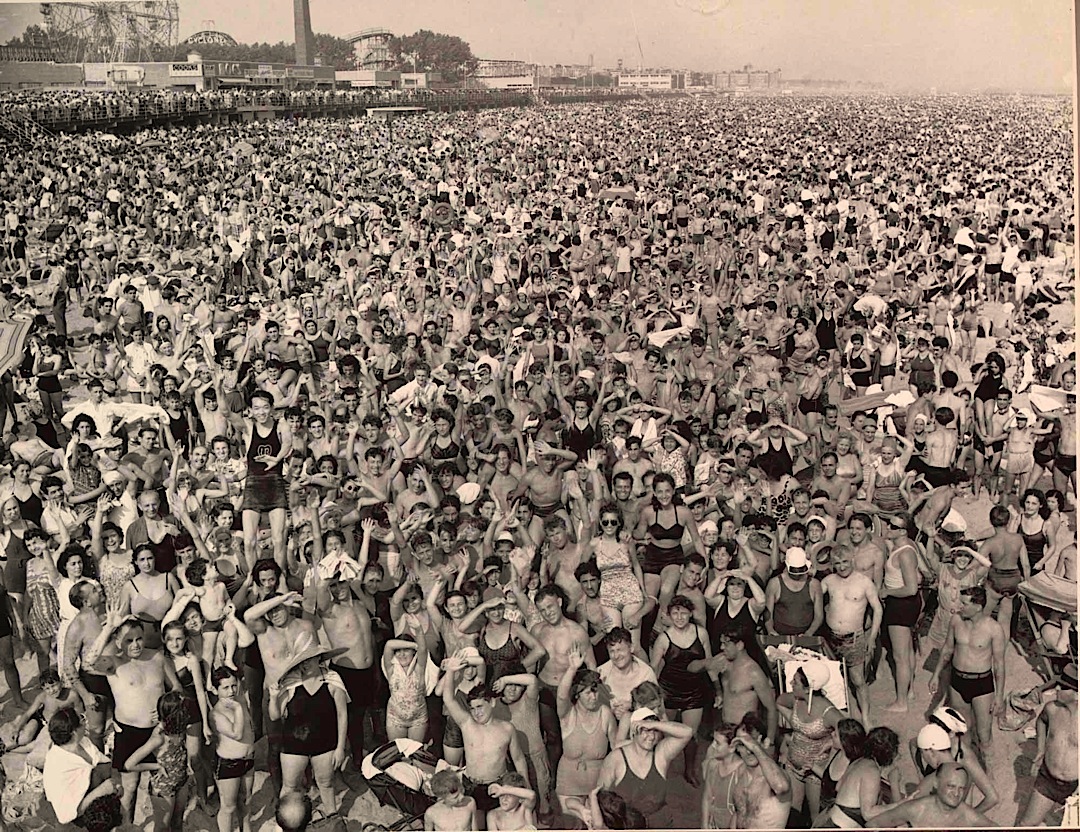
Coney Island, 1940
HAVE A GREAT LABOR DAY!
❖❖❖
THIS WEEK
RIDING THE WAVES
ON THE QUEEN ELIZABETH, Part One
by Brian Freedman
NEW YORK CORNER
RAYMI
by John
Mariani
❖❖❖
RIDING
THE WAVES ON THE QUEEN ELIZABETH
Part One
by Brian Freedman
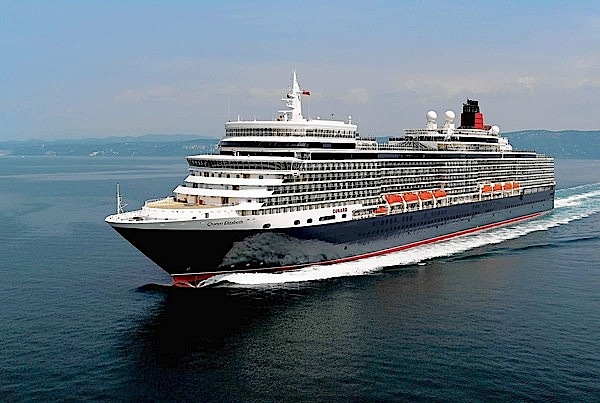
Before
leaving our apartment in Philadelphia for a cruise on
Cunard’s glorious new
RMS Queen
Elizabeth this summer, I received a startling
number of texts and emails from friends, all of them
bearing a strangely similar message: Make sure you
lean over the prow of the ship at some point and, like
the DiCaprio character in the movie, bellow out to the
breakers, “I’m the king of the world!”
I’m proud to report that I didn’t. It just
never occurred to me. Because once on board, the
entirety of the experience was so overwhelmingly
wonderful that middling concerns like recreating
iconic movie scenes--even on a ship as grand as
this--instantly receded from view.
The movies have nothing on the real-life
fantasy of the new Queen
Elizabeth.
Indeed, as a frequent traveler, I have grown
accustomed to the many and varied deprivations
required to traverse long distances: Truculent TSA
agents; unreasonable weight restrictions on luggage;
food that wouldn’t pass muster in a military brig;
even occasional domestic first-class air travel little
better than a standard seat on Amtrak. So when the
opportunity arose to experience Cunard’s legendary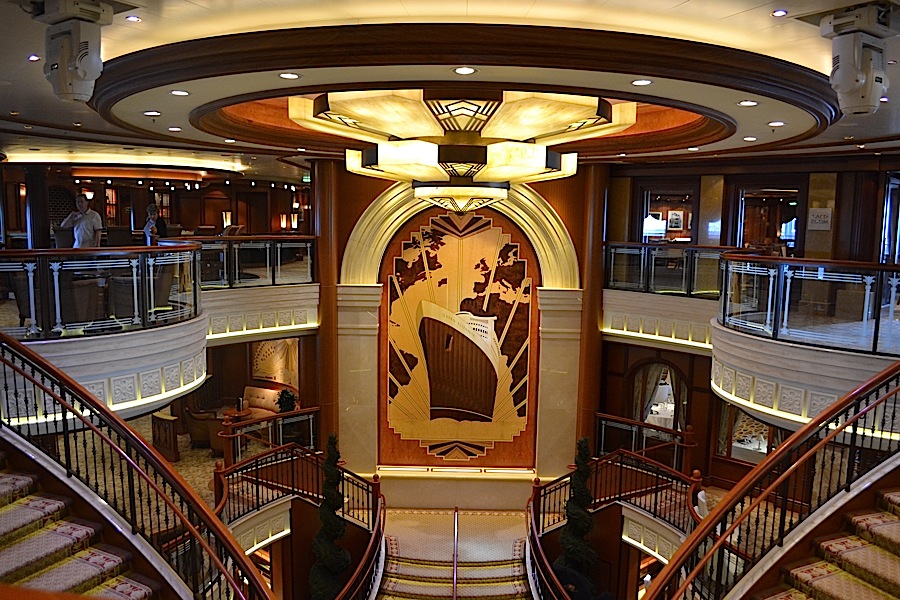 “White Star Service” firsthand, I
jumped at it. And with expectations that, I feared,
could never be met.
“White Star Service” firsthand, I
jumped at it. And with expectations that, I feared,
could never be met.
I was wrong. They weren’t only met, but far
exceeded.
My wife and I flew to Heathrow from
Philadelphia International on July 4th, taking off
just in time to catch the Independence Day fireworks
speckling the sky far below. From there, we took a car
service to Southampton, less than a two-hour drive
from London, and spent the day exploring through our
jet-lagged haze, trying to tamp down our excitement
for the ship’s departure the next day.
The following morning, upon opening the shades
in our hotel room--a more than serviceable Holiday
Inn--we discovered, looming above every other
waterborne craft at the dock, the iconic wedge of the
Queen Elizabeth,
its funnel seemingly standing sentinel over the town.
A few hours later, we were making our way through
security--a remarkably civilized affair--at the
embarkation center. And then, finally, off to the
gangway and into the ship.
Immediately upon entering, we were greeted by a
phalanx of crew members in their fresh-pressed
uniforms, each greeting us with a smile and a genuine
sense of warmth. We were booked for a Princess Grill
Suite, up on the eighth deck, but decided to take the
stairs instead of the elevator, the better to run our
hands over the polished woods and fittings, to take in
the photos at each landing of iconic Cunard passengers
of the past: Movie stars, athletes, natty travelers in
suits and jaunty hats.
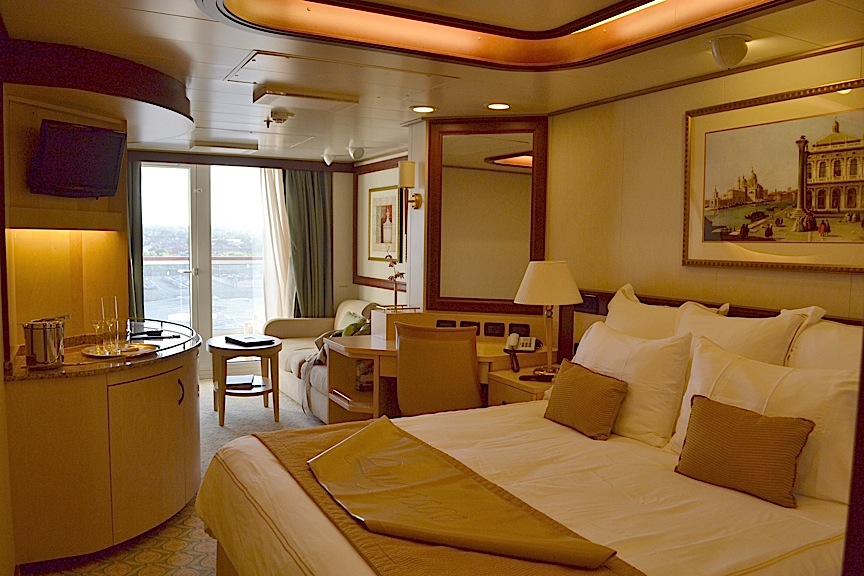 The new Queen Elizabeth is the third in a
proud line of Cunard ships. The first launched in
1938 but first served as a military ship until 1946,
but after many years of passenger service and several
owners, it caught fire in 1972 and capsized in Hong
Kong Harbor.
The new Queen Elizabeth is the third in a
proud line of Cunard ships. The first launched in
1938 but first served as a military ship until 1946,
but after many years of passenger service and several
owners, it caught fire in 1972 and capsized in Hong
Kong Harbor.
There are several levels
of accommodation aboard Cunard’s liners, though the
major distinction is between the standard staterooms
and the Grills. Guests staying in the Princess and
Queens Grill Suites take their meals in their
respective dedicated restaurants, elegant spaces where
meals are single-seating (meaning you can show up
whenever you like, as your table is reserved for you
alone; you won’t be turned or rushed at any point),
and where every table has a view out the windows
running the length of the 11th-floor room.
The Princess Grill Suites themselves are
gorgeous. Ours, number 8085, was at the center of the
ship, and boasted two beds that housekeeping converted
into a single large one at our request; a generous
living area replete with a comfortable couch, an
armchair that proved to be a second home of sorts for
me over the course of the voyage, a coffee table, two
televisions, and, through a floor-to-ceiling glass
door, a balcony with two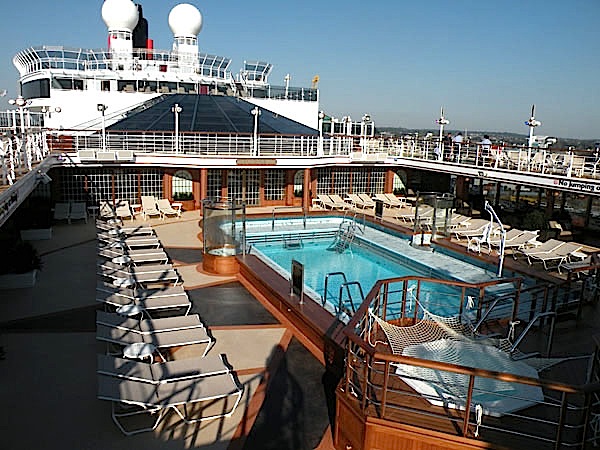 lounge chairs and a table.
The bathroom was exceptionally generous, with plenty
of counter space and a shower whose pressure was
frankly better than what I have at home. There was
also ample closet and storage space--necessary for a
cruise like this, with its three formal nights onboard
and subsequent necessity to pack a tuxedo, ball gowns,
and multiple pairs of shoes, not to mention the more
casual gear for off-ship excursions and downtime while
on-board.
lounge chairs and a table.
The bathroom was exceptionally generous, with plenty
of counter space and a shower whose pressure was
frankly better than what I have at home. There was
also ample closet and storage space--necessary for a
cruise like this, with its three formal nights onboard
and subsequent necessity to pack a tuxedo, ball gowns,
and multiple pairs of shoes, not to mention the more
casual gear for off-ship excursions and downtime while
on-board.
All Grills guests are greeted with fresh fruit
in a silver bowl and a bottle of sparkling wine: An
accurate indication of the level of service and
attention to detail to come. Nightly turndown service
(replete with chocolates), excellent bath-products
from Gilchrist & Soames--everything, it seems, has
been considered here, and considered brilliantly. For
all the lofty expectations I had about the experience,
for all the vaunted reputation of Cunard and its
liners--all of it pales in comparison to the reality.
Meals in the Princess Grill (below) were
sumptuous and not nearly as unvaryingly classical as
you might expect. And while we certainly enjoyed more
than our share of beautifully prepared
classics--gorgeous duck à l’orange
flambéed tableside, beef Wellington encased in
a shattering cocoon of puff pastry, escargots bourguignonne
as tender and exuberantly garlicky as you could wish,
one of the best Dover soles I’ve ever tasted--there is
also a real streak of internationalism underpinning
the offerings at each meal. The food on board the Queen Elizabeth,
crafted under the watchful eye of Executive Chef
Abhilash James, also includes preparations that
reflect the increasing diversity of the way people all
over the world are eating these days. To that end, we
tucked into a vividly spiced jumbo shrimp with X.O.
sauce and a soy mirin glaze, char sui pork and vegetable spring
rolls, and more.
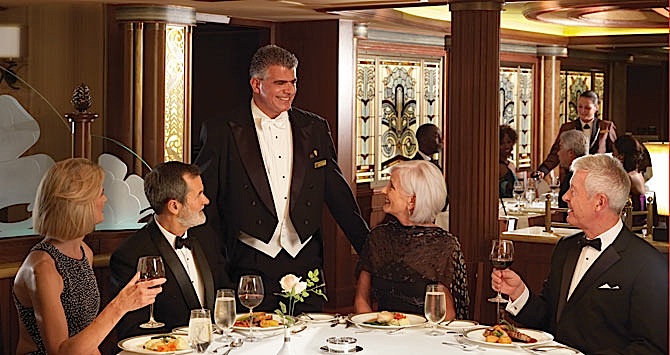 The
wine list is every bit as varied and thoughtful,
running the gamut from very fairly priced classed
growth Bordeaux all the way to intriguing, more
unexpected standouts from Israel, Austria, California,
and beyond. On the Queen
Elizabeth, the wine program is overseen by
the remarkable Chief Sommelier Dinesh Kathiresan and
the more than two dozen sommeliers under him. They
taste regularly--and run a fantastic tasting that
passengers can sign up for--are very well versed in
the wines and their pairing possibilities, and
unimpeachably helpful. Our sommelier for the week,
Laszlo, is from Hungary, and as passionate and
knowledgeable a sommelier as I’ve encountered
anywhere. (He’s also an expert on Tokaji, which made
dessert-wine time particularly enjoyable.)
The
wine list is every bit as varied and thoughtful,
running the gamut from very fairly priced classed
growth Bordeaux all the way to intriguing, more
unexpected standouts from Israel, Austria, California,
and beyond. On the Queen
Elizabeth, the wine program is overseen by
the remarkable Chief Sommelier Dinesh Kathiresan and
the more than two dozen sommeliers under him. They
taste regularly--and run a fantastic tasting that
passengers can sign up for--are very well versed in
the wines and their pairing possibilities, and
unimpeachably helpful. Our sommelier for the week,
Laszlo, is from Hungary, and as passionate and
knowledgeable a sommelier as I’ve encountered
anywhere. (He’s also an expert on Tokaji, which made
dessert-wine time particularly enjoyable.)
Of course, there are plenty
of other dining options as well on board the ship. The
Golden Lion (right),
a quintessentially English-style pub, glows with the
quiet masculinity of polished woods and a pressed tin
ceiling. The fish and chips here are excellent, as is
the chicken tikka
masala. As for the Guinness, 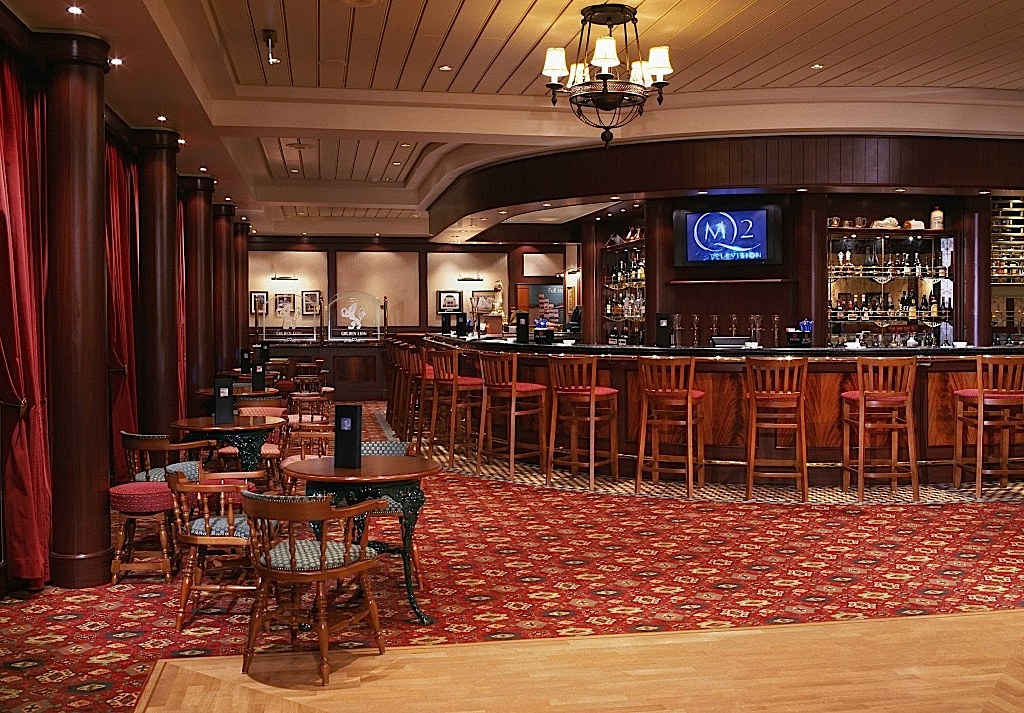 it’s perfectly pulled, velvety and
appropriately temperate. There’s also the more casual
Lido Buffet, the Britannia and Britannia Club dining
rooms, where non-Grills guests dine in double- and
single-seating meals respectively, and bars and
lounges throughout the ship. The Yacht Club is home to
very lively dancing in the evenings, and the Commodore
Club boasts a selection of “molecular martinis,”
thoroughly successful cocktails whose vermouth and
other flavoring components have been foamed, and rest
on top of the spirit like some sort of delicious royal
crown. Several times during our voyage, we took
advantage of the excellent afternoon tea, replete with
a wide selection of expertly brewed teas from around
the world and finger sandwiches from cucumber and
butter (no crusts on the bread, of course) to the
ship’s remarkable sliced salmon.
it’s perfectly pulled, velvety and
appropriately temperate. There’s also the more casual
Lido Buffet, the Britannia and Britannia Club dining
rooms, where non-Grills guests dine in double- and
single-seating meals respectively, and bars and
lounges throughout the ship. The Yacht Club is home to
very lively dancing in the evenings, and the Commodore
Club boasts a selection of “molecular martinis,”
thoroughly successful cocktails whose vermouth and
other flavoring components have been foamed, and rest
on top of the spirit like some sort of delicious royal
crown. Several times during our voyage, we took
advantage of the excellent afternoon tea, replete with
a wide selection of expertly brewed teas from around
the world and finger sandwiches from cucumber and
butter (no crusts on the bread, of course) to the
ship’s remarkable sliced salmon.
The jewel of the ship’s dining, however, is The
Verandah (below),
a fine-dining restaurant off the main stairway that is
an homage of sorts to the Verandah Grill on the first
Queen Elizabeth. The dining room
itself is polished to a shine, the side cart of
brandies and digestifs a golden-era beauty, the booths
looking out over the windows to the sea below. Guests
can order à la carte, but I’d recommend the
5-course tasting menu: At just $35 per person (plus
tax, gratuity, and alcohol), it is nothing short of a
bargain, especially when the procession of dishes
starts making its way out.
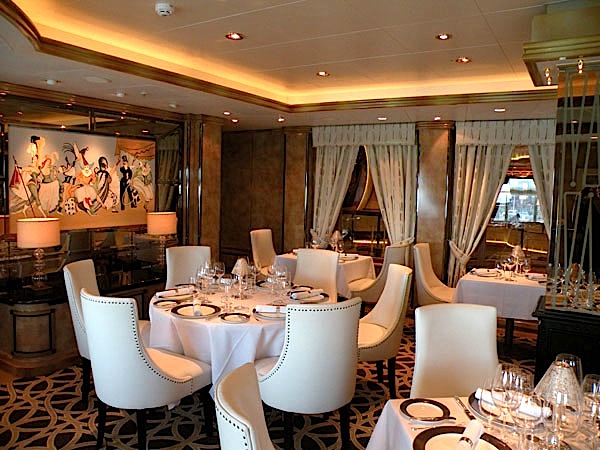 We started at the
bar with a lovely, refreshing hibiscus-Champagne
cocktail. From there, we settled into our booth by the
window--replete with crisp white tablecloth, elegant
stemware, and heavy silver--and immersed ourselves in
a three-hour-plus meal of remarkable elegance and
vigor. Our
tasting menu, like so much of the food onboard, ranged
from the classic to the more avant-garde, and all of
it was conceived with intelligence and prepared with
care and a minute attention to detail. A gorgeous
lobster and shellfish salad was accompanied by avocado
and tomato jelly. Duck foie gras torchon was
joined by pears and an addictive nougat brûlée.
Pan-roasted pigeon breast arrived beneath a smooth
dome of chocolate; a rich, impeccably balanced sauce grand veneur was
poured over it, melting and infusing the chocolate
into a sort of dizzyingly savory mole. Chestnuts,
quince, and endive provided the perfect lift to
counter it all. Seared langoustines and scallops
crowned herb-printed pasta as delicate and intricate
as vintage wallpaper, all of it tied together with an
ambrosial truffle emulsion. Organic filet of beef
mined a more classic vein with its soufflé
potatoes, morels, black truffles, and Madeira glaze.
For all the richness, the flavors remained vividly
clear and exuberant.
We started at the
bar with a lovely, refreshing hibiscus-Champagne
cocktail. From there, we settled into our booth by the
window--replete with crisp white tablecloth, elegant
stemware, and heavy silver--and immersed ourselves in
a three-hour-plus meal of remarkable elegance and
vigor. Our
tasting menu, like so much of the food onboard, ranged
from the classic to the more avant-garde, and all of
it was conceived with intelligence and prepared with
care and a minute attention to detail. A gorgeous
lobster and shellfish salad was accompanied by avocado
and tomato jelly. Duck foie gras torchon was
joined by pears and an addictive nougat brûlée.
Pan-roasted pigeon breast arrived beneath a smooth
dome of chocolate; a rich, impeccably balanced sauce grand veneur was
poured over it, melting and infusing the chocolate
into a sort of dizzyingly savory mole. Chestnuts,
quince, and endive provided the perfect lift to
counter it all. Seared langoustines and scallops
crowned herb-printed pasta as delicate and intricate
as vintage wallpaper, all of it tied together with an
ambrosial truffle emulsion. Organic filet of beef
mined a more classic vein with its soufflé
potatoes, morels, black truffles, and Madeira glaze.
For all the richness, the flavors remained vividly
clear and exuberant.
All of the ingredients at The Verandah, with a
very few exceptions, are sourced from small French
farms, and the quality of each shines through with
ringing clarity--the minerality of the beef, the
delicate gaminess of the pigeon, the depth of the foie
gras. This is highlighted even further by the wine
pairings, which run the gamut from Old World to New
World and hit a wide range of stops in between. The
Verandah itself is reason enough to book passage on
the Queen
Elizabeth. Dining this impeccably is rare
enough on land; the fact that Chef James, Dinesh
Kathiresan, and their team do it at sea is nothing
short of remarkable.
Eating this well requires a fair amount of
movement to work it off, and, aside from shore
excursions (more on that next week), there is plenty
to do on board to offset the effects of eating and
drinking so well. The Royal Spa is a calming,
beautifully run sanctuary that offers any number of
treatments, from facials and scrubs to more elaborate
massages and other body treatments.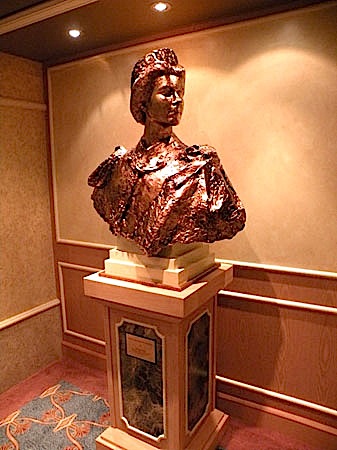 The fitness
center boasts weights and cardio equipment, and
there’s an outdoor loop that more guests than I
expected took advantage of for jogging and walking. It
was a bit chilly for me to dip into the outdoor pool,
but that didn’t stop others from enjoying either it or
the whirlpool. Perhaps they’re made from heartier
stock than I am.
The fitness
center boasts weights and cardio equipment, and
there’s an outdoor loop that more guests than I
expected took advantage of for jogging and walking. It
was a bit chilly for me to dip into the outdoor pool,
but that didn’t stop others from enjoying either it or
the whirlpool. Perhaps they’re made from heartier
stock than I am.
My main form of exercise
on board the Queen
Elizabeth was an almost nightly rotation of
dancing in the Queen’s Room, a golden bust of the
monarch standing sentinel at the entrance, the music
of the live orchestra ringing out beautifully. This
was generally followed by a restorative cocktail
upstairs at the Commodore Club and a nightcap game of
table tennis on the deck, the last vestiges of
sunlight painting the sky a kaleidoscope of colors
around midnight once we were up in the North Sea and
into the fjörds.
Queen Elizabeth
is a thoroughly modern ship that retains a wholly
appropriate sense of reverence for its past, a
supremely elegant way to travel that never feels
stuffy or stodgy. Quite the opposite, in fact: The
ship’s and the line’s heritage lend everything here a
sense of glittering excitement that never feels
forced. Camaraderie in the dining room with
neighboring tables inevitably develops by the second
day onboard. The crew are uniformly professional and
trained to a polish, yet wonderfully friendly, and,
somehow, have the uncanny ability to know your name by
the end of the first day. Even the sumptuousness of
the surroundings is rendered in such a way that it
feels like home before the first night is through.
My wife and I felt this on the very first
night, which we spent in what I imagine is the single
best way we could have. After Champagne and
canapés in our room late that afternoon, and
dinner overlooking the English Channel--and after, of
course, our table tennis on deck--we headed back to
our suite, changed into our plush bathrobes and
bedroom slippers, and stepped out to our balcony. I
poured glasses of the remaining bubbly, and we stood
there, transfixed by the moonlight slashing directly
toward us, the watering exploding in a fireworks
display of moonlight and stars, and France, off in the
distance, glittering across the Strait of Dover.
If this isn’t the single best way to travel, I
remember thinking, then nothing is.
❖❖❖
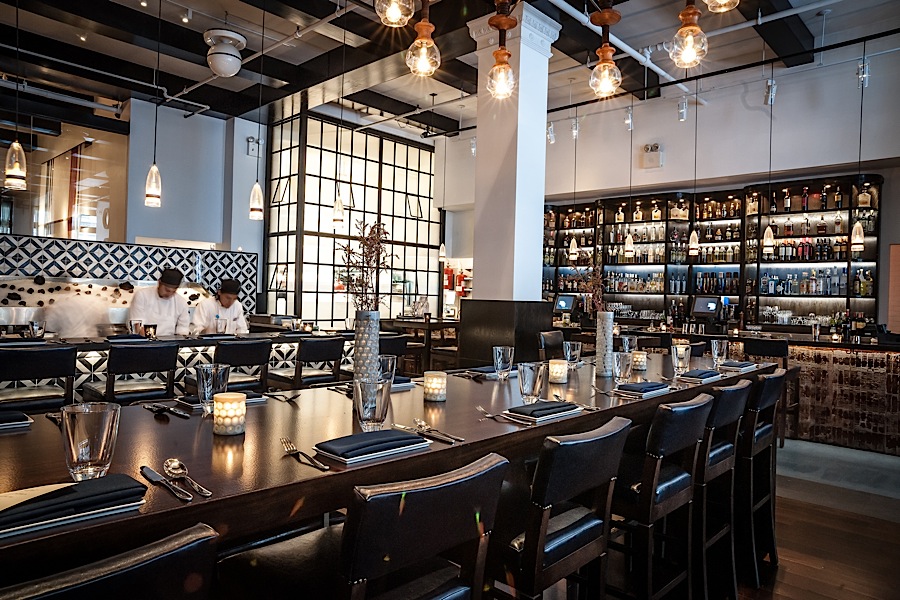 RAYMI
RAYMI43
West 24th Street
212-929-1200
www.richardsandoval.com/raymi
The media huzzah about how
Peruvian food was going to the Next Big Thing in 2012
didn't exactly pan out, but if canny restaurateurs
visit Raymi, which opened a month ago in the Flat Iron
district, maybe they might bring the idea into better
focus in 2013.
Actually, at Raymi, peripatetic
chef-restaurateur Richard Sandoval, whose empire is
now global, is here celebrating "the multicultural
spirit of Peru, blending the Spanish, Japanese,
Chinese, and native influences that embody the
country’s vibrant cuisine." That's a lot to swallow
but I think this is the best of Sandoval's restaurants
(of those I've visited) in a long, long time.
The place is a knock-out: big,
wide, deep, with high ceilings, a bit loud at the bar
(above)--and
it's a helluva great bar--clever use of wooden
shutters, tapestry upholstery, and brown leather
banquettes. The Pisco Bar lists 30 house-infused
versions of that Peruvian spirit. The service
staff is well informed about the long menu here, but,
at least on the night I visited, either overwhelmed by
too many tables or just simply absent from the dining
room.
Chef
Erik Ramirez, last at Eleven Madison Park, worked with
Sandoval and Peruvian chef Jamie Pesaque, to 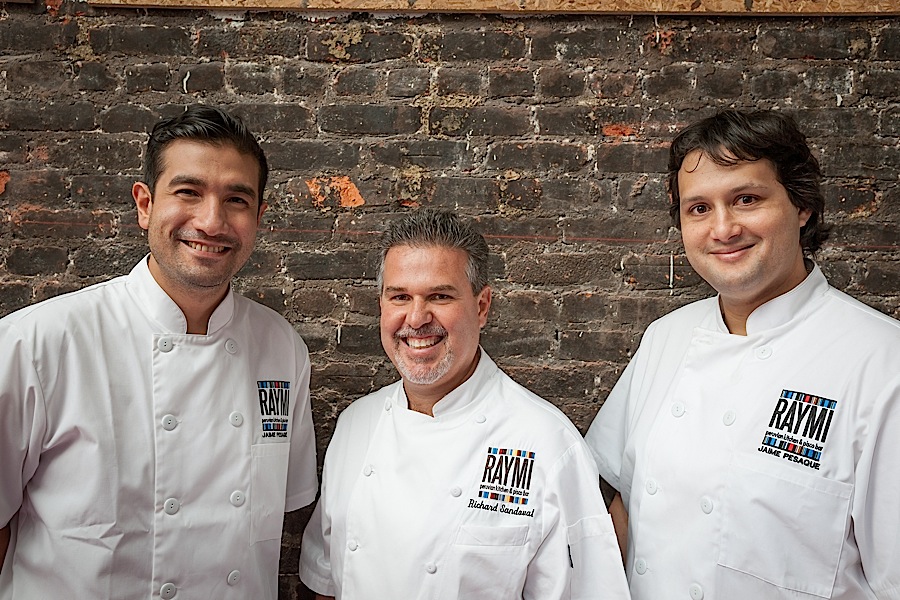 make
sure The Ceviche Bar is a big feature here, and
a lot of the tapas-style items are unique, so have a mixto, which
includes aji rocoto
peppers, shrimp, octopus, scallops, sweet potato, and
toasted corn.
make
sure The Ceviche Bar is a big feature here, and
a lot of the tapas-style items are unique, so have a mixto, which
includes aji rocoto
peppers, shrimp, octopus, scallops, sweet potato, and
toasted corn.
Of the Peruvian sushi
offerings--and you may remember Peru is where Nobu
Matsuhisa developed his style of sushi--I enjoyed the
scallop and cape gooseberry with a crunch of candied
ginger and poppyseed that gave it additional texture
and nuttiness. And you could go right on through the
appetizers and be perfectly happy with a full meal.
There is a causa
of the day--a causa
being a yellow potato (potatoes actually originated in
Peru long before any Irishman ever ate one) with an aji puree. The
corn empanada is terrific, toasty, with yellow chile,
mozzarella, cilantro and chimichurri, then there are
skewers called anticuchos
done a la plancha
(on the griddle), like the juicy hanger steak with ajo glaze and rocoto
salsa. This is all highly colorful food
with real snap, fun to eat, serious in conception.
As you tell, this is spicy food,
but there are always varying degrees within one dish,
and sweetness often comes into play, too. The Peruvian
shrimp bisque with aji
panca, fava beans and a poached egg is
marvelously rich and satisfying, with wonderful aroma.
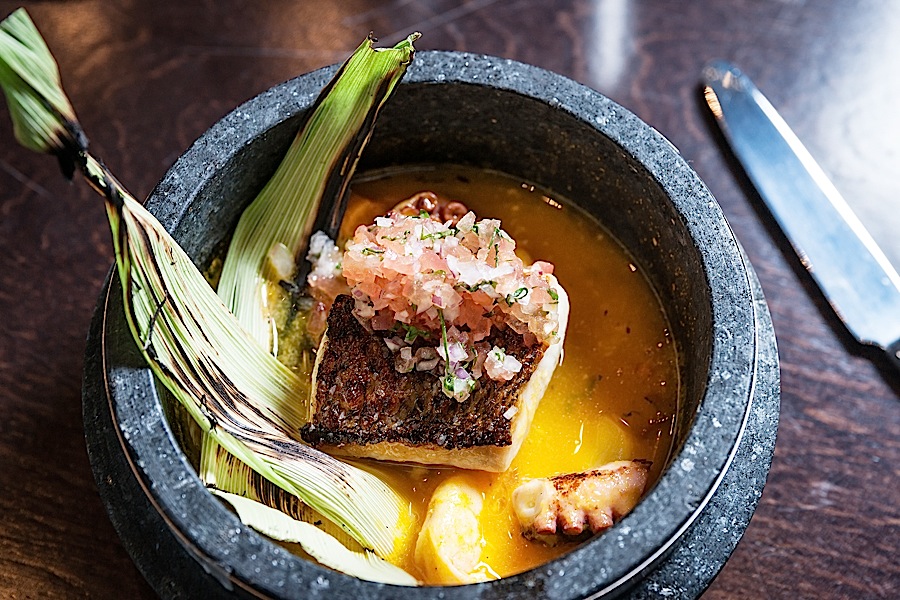 Well, there
are plenty of other starters here, but if you are up
for the main courses, go right ahead and enjoy the
ceviche done on a hot rock with leche de tigre
sauce--it's brilliant--or a traditional arroz con pato
(duck) done with tender Canaroli rice, scallops, and
cilantro. Chaufa
completo is a rice dish derived from Chinese
food culture, with fragrant jasmine rice, chicken char siu, shrimp
and Chinese sausage. It all works at Raymi and
shows just how close two continents are when their
food cultures collide.
Well, there
are plenty of other starters here, but if you are up
for the main courses, go right ahead and enjoy the
ceviche done on a hot rock with leche de tigre
sauce--it's brilliant--or a traditional arroz con pato
(duck) done with tender Canaroli rice, scallops, and
cilantro. Chaufa
completo is a rice dish derived from Chinese
food culture, with fragrant jasmine rice, chicken char siu, shrimp
and Chinese sausage. It all works at Raymi and
shows just how close two continents are when their
food cultures collide.
Do not skip dessert--you've gone
this far, so indulge in a luscious dulce de leche
panna cotta with chocolate walnuts and burnt meringue,
or the rice pudding with golden raisins, and brown
butter ice cream. Of course, you'll want to
split the crispy donuts with chancaca honey.
If you stick with the ceviches and
starters, the bill can add up, if you're really really
hungry, but nothing tops $16 on that part of the menu,
and the large portions fort main courses run $22-$26,
with a NY strip steak with sides going for $32.
Raymi is certainly a signal for
anyone interested in modern Peruvian food and for any
other restaurateur who thinks that maybe, just maybe,
he can do it as well. Not likely.
Raymi
is open for lunch Mon.-Fri., for dinner nightly.

CANCEL OUR
RESERVATION. . . FOREVER!
Kenny Shopsin, chef-owner of
a diner on NYC's Lower East Side, hates customers
who ask for food the way they like it. “Some
people tell me that they’re deathly allergic to
something and that I have to make sure it’s not in
their food. I kick them out,” Shopsin writes in his
book Eat Me: The Food and Philosophy of
Kenny Shopsin. He recommends they “go eat at a hospital”
instead.

Tennis star Maria Sharapova has launched a new line
of candy called
❖❖❖
Any of John Mariani's books
below may be ordered from amazon.com.
 |
My latest book, which just won the prize for best book from International Gourmand, written with Jim Heimann and Steven Heller, Menu Design in America, 1850-1985 (Taschen Books), has just appeared, with nearly 1,000 beautiful, historic, hilarious, sometimes shocking menus dating back to before the Civil War and going through the Gilded Age, the Jazz Age, the Depression, the nightclub era of the 1930s and 1940s, the Space Age era, and the age when menus were a form of advertising in innovative explosions of color and modern design. The book is a chronicle of changing tastes and mores and says as much about America as about its food and drink.
“Luxuriating vicariously in the pleasures of this book. . . you can’t help but become hungry. . .for the food of course, but also for something more: the bygone days of our country’s splendidly rich and complex past. Epicureans of both good food and artful design will do well to make it their coffee table’s main course.”—Chip Kidd, Wall Street Journal.
“[The menus] reflect the amazing craftsmanship that many restaurants applied to their bills of fare, and suggest that today’s restaurateurs could learn a lot from their predecessors.”—Rebecca Marx, The Village Voice. |
"Eating Italian will never be the same after reading John Mariani's entertaining and savory gastronomical history of the cuisine of Italy and how it won over appetites worldwide. . . . This book is such a tasteful narrative that it will literally make you hungry for Italian food and arouse your appetite for gastronomical history."--Don Oldenburg, USA Today. "Italian
restaurants--some good, some glitzy--far
outnumber their French rivals. Many of
these establishments are zestfully described
in How Italian Food Conquered the World, an
entertaining and fact-filled chronicle by
food-and-wine correspondent John F.
Mariani."--Aram Bakshian Jr., Wall Street
Journal.
"Equal parts
history, sociology, gastronomy, and just
plain fun, How Italian Food Conquered the
World tells the captivating and delicious
story of the (let's face it) everybody's
favorite cuisine with clarity, verve and
more than one surprise."--Colman Andrews,
editorial director of The Daily
Meal.com. "A fantastic and fascinating
read, covering everything from the influence
of Venice's spice trade to the impact of
Italian immigrants in America and the
evolution of alta cucina. This book will
serve as a terrific resource to anyone
interested in the real story of Italian
food."--Mary Ann Esposito, host of PBS-TV's
Ciao
Italia. "John Mariani has written the
definitive history of how Italians won their
way into our hearts, minds, and
stomachs. It's a story of pleasure over
pomp and taste over technique."--Danny Meyer,
owner of NYC restaurants Union Square Cafe,
Gotham Bar & Grill, The Modern, and
Maialino.
|
 |
 |
 |
 |
 |
 |
 |
 |
 Everett Potter's Travel Report:
Everett Potter's Travel Report: 
 Eating Las Vegas
is the new on-line site for Virtual Gourmet
contributor John A. Curtas., who since 1995
has been commenting on the Las Vegas food
scene and reviewing restaurants for Nevada
Public Radio. He is also the
restaurant critic for KLAS TV, Channel 8 in
Las Vegas, and his past reviews can be
accessed at KNPR.org.
Click on the logo below to go directly to
his site.
Eating Las Vegas
is the new on-line site for Virtual Gourmet
contributor John A. Curtas., who since 1995
has been commenting on the Las Vegas food
scene and reviewing restaurants for Nevada
Public Radio. He is also the
restaurant critic for KLAS TV, Channel 8 in
Las Vegas, and his past reviews can be
accessed at KNPR.org.
Click on the logo below to go directly to
his site.

Tennis Resorts Online: A Critical Guide to the World's Best Tennis Resorts and Tennis Camps, published by ROGER COX, who has spent more than two decades writing about tennis travel, including a 17-year stretch for Tennis magazine. He has also written for Arthur Frommer's Budget Travel, New York Magazine, Travel & Leisure, Esquire, Money, USTA Magazine, Men's Journal, and The Robb Report. He has authored two books-The World's Best Tennis Vacations (Stephen Greene Press/Viking Penguin, 1990) and The Best Places to Stay in the Rockies (Houghton Mifflin, 1992 & 1994), and the Melbourne (Australia) chapter to the Wall Street Journal Business Guide to Cities of the Pacific Rim (Fodor's Travel Guides, 1991).


MARIANI'S VIRTUAL GOURMET
NEWSLETTER is published weekly. Editor/Publisher: John
Mariani.
Contributing Writers: Christopher Mariani, Robert Mariani,
John A. Curtas, Edward Brivio, Mort Hochstein,
Suzanne Wright, and Brian Freedman. Contributing
Photographers: Galina Stepanoff-Dargery,
Bobby Pirillo. Technical Advisor: Gerry McLoughlin.
To un-subscribe from this newsletter,click here.
© copyright John Mariani 2012
